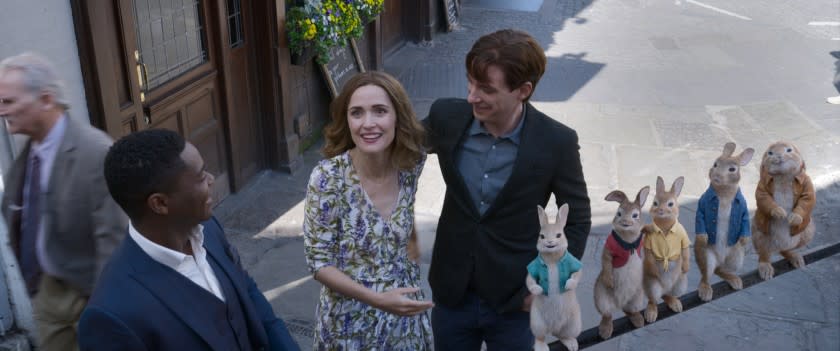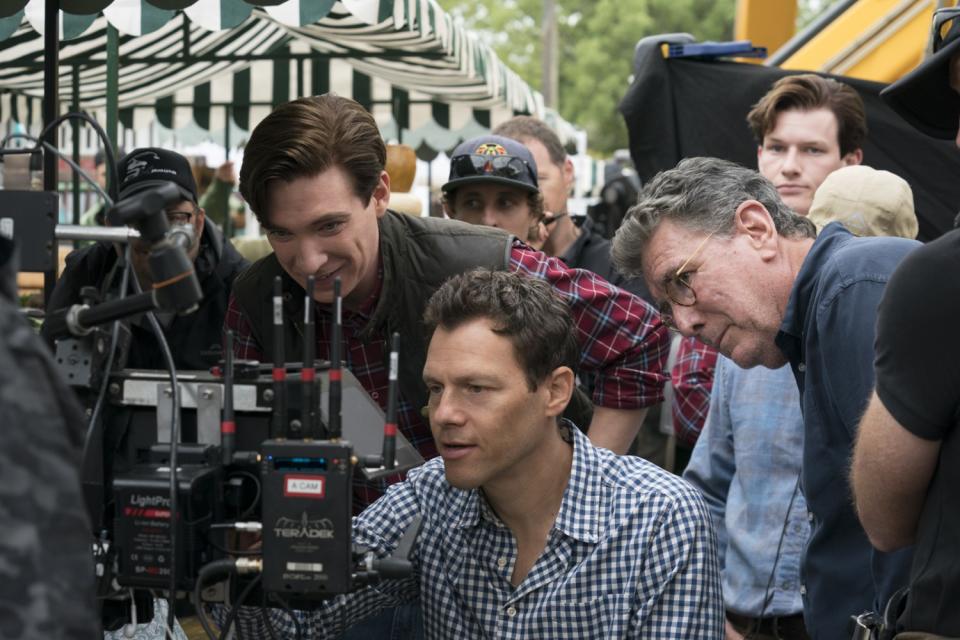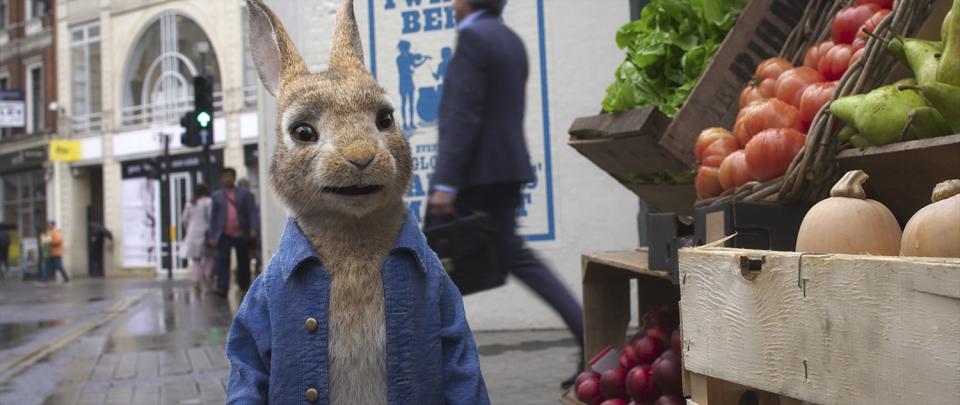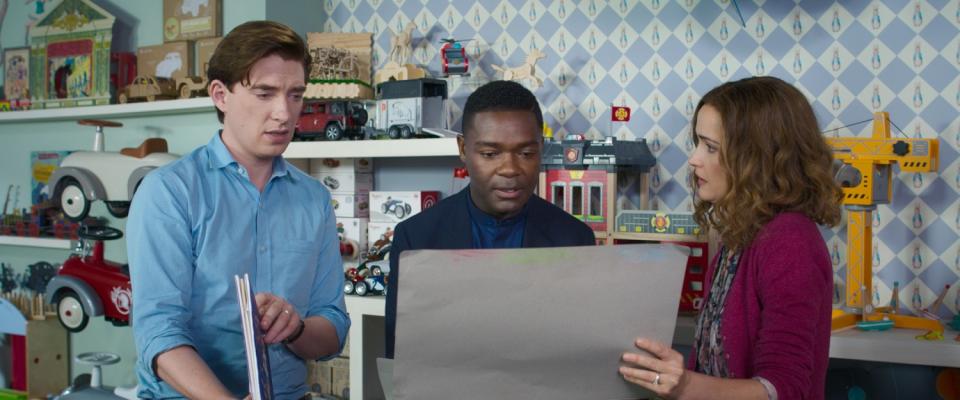'Peter Rabbit 2' shows how making a movie with digital bunnies can get hare-y

- Oops!Something went wrong.Please try again later.
- Oops!Something went wrong.Please try again later.
- Oops!Something went wrong.Please try again later.
On a sunny April morning, as director Will Gluck called “Action!” on a scene in “Peter Rabbit 2: The Runaway,” the star of the movie was nowhere to be found. The film’s production, which took place in Australia and England in the spring of 2019, was unique in that its lead character, Peter Rabbit, was added only after filming was complete. The process of making a movie without the tangible presence of its leads is a challenge as Gluck knows from his experience making 2018’s live-action hybrid “Peter Rabbit.”
“That movie was definitely a learning experience for me because I didn’t understand how it worked,” Gluck says of filming a movie with CGI animated characters set in the real world. “I don’t know if I still do, but I now have a better version of it.” The sequel, after quite a bit of hopping around the release schedule due to the pandemic, opens Friday in the U.S.
Ahead of shooting, Gluck and second unit director Kelly Baigent storyboarded every shot of the movie, which sees Peter team up with a gang of thieves after he runs away from his farm. The team then created what’s called an “animatic,” a hand-drawn storyboarded film with temporary voices and music to use as a blueprint for what they’d need to capture on set. Gluck’s main unit shot everything involving the human cast, which includes Rose Byrne as Bea McGregor, Domhnall Gleeson as Thomas McGregor and new addition David Oyelowo, who plays a devious publisher hoping to take advantage of Bea’s stories about the rabbits. Meanwhile, Baigent was tasked with filming any footage that would include Peter (James Corden) and his pals, including shots with human extras and stunts.

“One thing that was really important to me was, Peter Rabbit being the star of the film, we weren’t just taking still shots and plunking him in there,” Baigent explains. “My objective was to treat it as if it was a real film and we were moving around the world with our characters through that world. That created a lot of technical challenges for us. It was an interesting mix of ultra high-tech, with rendering and lighting that came in from a VFX standpoint, and ultra low-tech, like people holding sticks with plastic rabbits. It meant that we were able to achieve a really immersive experience.”
During the day on set two years ago, a scene where Bea, Thomas and Oyelowo’s Nigel Basil-Jones are marveling at a billboard alongside Peter and his rabbit friends revealed how the actors dealt with the lack of real co-stars. The scene was rehearsed and shot once with plastic rabbits on long sticks held by puppeteers who stand in for the eventual CGI versions. Then the scene was shot again with a “ghost pass,” where the actors interact with nothing. Sometimes, they use weighted blue stuffed animals to get the feel of a rabbit that’s being held. But Gluck says a lot of the time it’s the ghost pass that gets used in the film.
“I have an emotional, complicated relationship with something that isn’t there,” Byrne says. “It was challenging on the first film. You’ve got to have a sense of humor about it otherwise you just go crazy. You have to draw on your resources, like monologue classes and acting classes. It’s like doing a monologue where you’re trying to engage with the audience, but there’s no audience. You have to pull from the imagination as best you can. And Will is tracking all of that and the technicality of what I’m doing.”
“If I have a rabbit-shaped blue thing in my hand I still feel a little silly but I have something,” Oyelowo adds. “The ghost pass, where you suddenly become a mime artist, is when it gets really hairy. You have a simulation of what it’s going to be, but by and large, you’re imagining how it feels to be kicked in the groin by a rabbit. And then you’re acting it out, trusting that someone somewhere is going to work very hard on your groin hit and make it work. There’s a lot of faith.”
There are a lot of technically challenging moments in “Peter Rabbit 2,” but its opening sequence, where Peter fantasizes about attacking Thomas during his wedding to Bea, proved to be especially tricky. Peter kicks Thomas squarely in the face, which was obviously impossible to actually do.

“The only way we got to do that — which was my favorite moment as a director — is Domhnall had to put on a blue glove and hold a book wrapped in blue,” Gluck recounts. “And just smack himself in the face over and over again. When he smacks himself we wanted a little bit of spit to come out, which meant egg whites. So this poor actor, on a hot Sydney day, had to hold egg whites in his mouth and smack himself in the mouth and do it again and again. That’s how it looks like Peter Rabbit is kicking Domhnall.”
“It’s total choreography,” Gleeson says. “You can still ad-lib and stuff like that, but for the physical fight scenes, you really want to know what you’re doing. The last thing you want is to be grabbing something or looking in the wrong direction and they can’t use the best take. You’re not just acting.”
For the scenes without the human actors, Baigent and VFX supervisor Will Reichelt had to think about a lot of factors. For example, if the camera is meant to be following Peter as he runs, how quickly should it move? The speed at which Peter and his friends walk or run is based on the speed of real rabbits, although it’s been slightly reduced for the purpose of narrative timing.
“We started out with cheat sheets,” Reichelt explains. “I’ve got a set of laminated cards that says things like ‘Peter Rabbit: quad-walk walk speed, bipedal walk speed.’ So if the [director of photography] says ‘I need to pan from there to there with Peter, how fast is he traveling?’ I can go, ‘Well, he’s traveling three meters per second because he’s running on all fours.’ Then we can plot that out. And then after a while it’s second nature.”

When the animals interact with real-world objects, like food or puddles, much of that is also done in-camera using special effects. Gluck jokes that the film should be sponsored by a fishing company because the crew was constantly pulling props around on fishing line. “You have this gigantic budgeted movie and it all rests on whether someone can pull a fishing line and get the cupcake to move,” the director notes.
“As a general rule if you can get it in-camera, you do get it in-camera,” Baigent adds. “For example, if something is falling into the water, water is a famously tricky thing to deal with in computers. We would always try to create a splash with a very well-timed rock being thrown in. It can look utterly absurd.”
Once the film was shot, an entire second film had to be made during post-production. Australian company Animal Logic, who designed the characters in the first film, worked with the VFX team to animate realistic, fur-covered rabbits who fit seamlessly into the existing footage. They also designed and created several new animal characters. A lot of the success in post-production relied on data and reference footage gathered during filming, including 360-degree shots of each scene used to show the placement of the sun and lighting. It’s a process that relies on getting things right the first time, which everyone had a better handle on with the sequel.
“Being a director, they always say, is the illusion of control,” Gluck laughs. “And this movie you really have to have that illusion. It was me and the crew together figuring it out. But many times I’d film it and go, ‘Is this gonna work?’ And it always works. The question is how much work do you have to do in post-production to fix your mistakes in production. The key to watching this movie is that you forget within five minutes how it’s working. And I think we’ve done a successful job of that. You want to feel like it’s seamless.”
This story originally appeared in Los Angeles Times.

